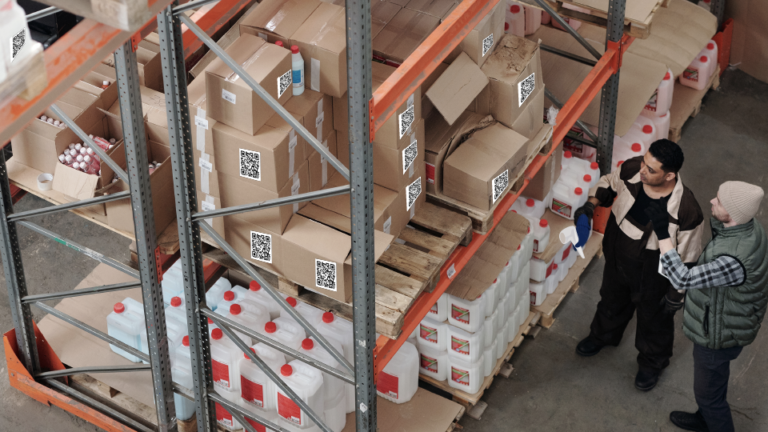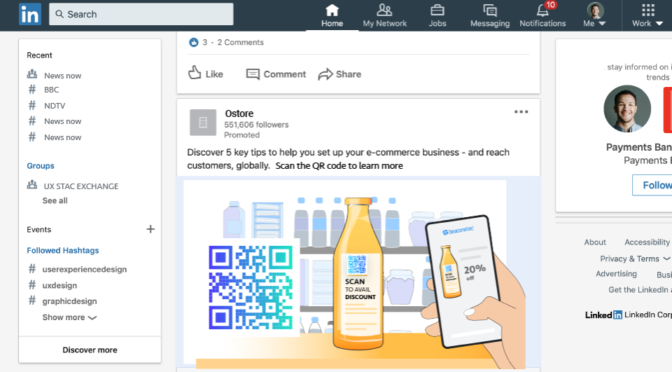Supply chain processes and inventory management have undergone a sea of changes in the past few decades. Undoubtedly, so has the technology used to simplify these complex processes.
In 1974, the standardized, one-dimensional Universal Product Code (UPC) barcode revolutionized stock management. But now, more than fifty years later, there is a growing need to switch to QR Codes for inventory management.
In fact, many retailers globally, such as Coca-Cola, L’Oreal, and Procter and Gamble, are working towards replacing barcodes with QR Codes by 2027.
Why make this switch? QR codes can carry a much larger amount of data than barcodes, which in turn also helps in higher rates of customer engagement as consumers can access data about sustainability, product information, etc. We’ll further expand on the benefits of using QR Codes for inventory management later in this blog, along with the steps to implement it and some real-world examples.

Table of Contents
- How does a QR Code work in inventory management?
- Benefits of QR Codes for inventory management
- Real-world examples of QR Code for inventory management
- How to create a QR Code for inventory management
- Bulk QR code generation for large enterprises
- QR Code for Inventory Management: Use Cases
- Barcodes vs QR Codes
- Frequently asked questions
How does a QR Code work in inventory management?
Using QR Codes for inventory management could be described as using a ‘supercharged filing system’ for your products. It’s as simple as this:
- Each product is assigned a unique QR Code.
- The QR Code stores a ton of information about the product. This could include name, batch number, expiration date, location, and price.
- Scanning the QR code gives you this information instantly and updates it in real-time.
Here’s a breakdown of how QR Codes can simplify the different aspects of inventory:
| Process | With QR Codes | Advantages |
| Receiving & Stocking | Scanning QR Codes automatically updates the inventory system with product details (batch number, expiry date, quantity, etc.). | Faster check-in and reduced manual errors. |
| Storage & Organization | QR Codes provide real-time tracking of inventory across shelves, warehouses, or even different geographic locations. | Improved visibility, reduced misplacement, and efficient inter-warehouse transfers. |
| Tracking Usage & Consumption | Scanning a QR Code before use updates stock levels in real-time. | Prevents stockouts and improves inventory accuracy. |
| Reordering & Restocking | QR Codes trigger auto-restock alerts when stock reaches a pre-decided number. | Speeds up restocking and prevents shortages. |
| Compliance & Expiry Management | QR Code scans flag soon-to-expire or recalled items. | Ensures safety and reduces waste. |
| Asset & Equipment Management | QR Codes provide real-time location and maintenance history for each asset. | Better equipment utilization and fewer lost assets. |
Benefits of QR Codes for inventory management
While one mostly thinks of QR Codes for marketing as the most common use case, the advantages they offer when it comes to asset management can truly transform the way we do business globally and across industries. Here are a few benefits of QR Code in inventory management:
1. Efficiency and Ease of Use
QR codes streamline and simplify inventory tracking and management through:
✅ Compact Size & Scannability: Can be scanned from any angle using smartphones, tablets, or scanners, reducing errors.
✅ Damage Resistance: Remains scannable even if up to 30% of the code is damaged, ensuring reliability in warehouses and transit.
✅ Customization: Can be branded with logos, colors, and embedded links to enhance product tracking and authentication.
2. Real-Time Tracking and System Integration
QR codes provide instant access to inventory data, improving stock visibility and logistics:
✅ Live Inventory Updates: Tracks stock movement in real-time, reducing manual errors.
✅ Cloud & ERP System Integration: Syncs inventory data across platforms for seamless management.
✅ Improved Security: Role-based access ensures only authorized personnel can update or modify records.
“QR codes don’t just capture inventory data; they ensure the right person is handling it. Within the software, QR codes validate who is loading or managing inventory, preventing unauthorized handling.”
– Sam Titus, CTO of FreightPrint, The New Warehouse podcast
3. Business Growth & Cost Savings
QR codes help businesses scale efficiently while reducing operational costs:
✅ Reduced Manual Work: Eliminates tedious stock-taking, cutting down on labor costs.
✅ Better Decision-Making: Enhances demand forecasting and reorder planning.
✅ Scalability: Grows with your business, making it easy to expand inventory tracking without significant investment.
✅ Mobile Accessibility: Employees can use smartphones and tablets for real-time stock updates without needing dedicated barcode scanners.
“QR codes aren’t just for warehouses with specialized scanners anymore. Anyone with a phone can scan them, meaning customers, clients, and consignees can access inventory data instantly.”
– Sam Titus, CTO of FreightPrint, The New Warehouse podcast
Real-world examples of QR Code for inventory management
Retail
Smart packaging involves integrating QR Codes in retail inventory management. This enhances product tracking, supply chain efficiency, product authentication and even customer engagement. Further, automated warehouse robots can streamline retail inventory tracking by combining precise scanning with automated handling.
“In addition to the shopper engagement opportunities that 2D barcodes provide, these data-rich QR codes will also better support our inventory management operations so that we can keep our shelves stocked with the products our customers want most.”
– Dave DeLaus, senior vice president and chief information officer, Wegmans Food Markets, Inc.
In fact, the move to replace barcodes with QR Codes in retail by 2027 is very much underway and known as Sunrise 2027. According to Iain Walker, GS1 director of industry engagement, “By linking QR codes to inventory management systems, retailers can quickly locate and remove recalled products from shelves, minimizing potential harm to consumers and improving efficiency.” This also simplifies cases where a product’s total recall must be initiated.
Nutura Organic, an Australian baby formula brand, tackled the growing issue of counterfeit products in the APAC region using QR Codes. To ensure authenticity, the company laser-printed QR codes on packaging during production. Consumers scanned these codes to instantly access the digital product license plate, verifying that their purchase was genuine and safe.
Manufacturing
The inventors of the QR Code, Toyota, use QR Codes to fuel its Just-In-Time strategy, also known as Quick Response Manufacturing. Employees use QR Codes to track precise stock levels and avoid overproduction.
General Electric (GE) prints QR Codes that can be used as stickers for machines and equipment. On the plant floor, users can scan the QR Code to access detailed information. This can help operators reduce their downtime, and managers monitor trends.
Warehousing
In 2020, a San Francisco-based startup called Ware launched drones with cameras to oversee the products in a warehouse and scan the QR Codes on each product. Ware is able to show users which pallets are on which racks – and where those racks are located within the warehouse. Additionally, because the system knows the contents of each pallet, it can track how many of any given product is currently in the building.
“Traditionally, we’ve used standard barcodes for locations, labels, and LPNs (License Plate Numbers) in warehouses, but moving to a QR code-friendly warehouse is a game changer. QR codes store a lot more data, making them far more versatile.”
– Sam Titus, CTO of FreightPrint, The New Warehouse podcast
Healthcare
The use of QR Codes in the healthcare and pharmaceutical industry can aid not just inventory management, but also through QR Code packaging, lead to decline in fake drugs.
In March 2023, the department of pharmaceuticals (DoP) in India, shortlisted 300 drug brands that were required to print QR codes on their packaging in a bid to reduce counterfeit drugs sold in India.
Read more about the use of QR Codes in healthcare.
Logistics
In March 2024, LKW Walter, a well-known German operator that specializes in frozen food transport and storage, implemented electronic transport documents using QR Codes and eliminated the use of paper documents.
“The driver only receives a QR code, which he shows to the recipient. After scanning the barcode, the driver and the consignee confirm the delivery on the tablet. Using the link behind the QR code, the driver has mobile access to the delivery confirmations via smartphone if they are needed during the route,” the operator explains.
How to create a QR Code for inventory management
The only way to create a QR Code for inventory management is to use Dynamic QR Codes (as opposed to static QR Codes), and the easiest way to generate a dynamic QR Code is by using Uniqode’s dynamic QR Code generator. Follow the simple steps below:
Step 1: Log in to the dashboard and click +Create
To access the Uniqode dashboard, you can sign up for a free trial. Once you log-in to the dashboard, click +Create and QR Codes
Step 2: Choose the type of dynamic QR Code
You can use dynamic QR Codes to show varied content, from PDFs, mp3s, menus, forms, links to landing pages.
Step 3: Insert the URL of the content
For example, if you plan to share a PDF, you can choose the PDF option and either upload the PDF or insert the URL if it is hosted online.
Enable the sharing settings so your audience can view it.
Step 4: Customize the dynamic QR Code
You can customize the dynamic QR Code as per your branding:
- Customize the eyes and the eye shape
- Customize the data pattern, change its color, or add a gradient
- Go for a color background, add an image, or keep it transparent
- Add a QR Code border
- Add a CTA that provides a preview of what the QR Code is linked
Step 5: Download the dynamic QR Code in the format of your choice
You can download the dynamic QR Code in formats such as PNG and JPEG (suitable for use on packaging materials).
For resizing purposes or use on larger materials and screens, go for high-quality QR Code formats such as SVG and EPS.
One of the most useful features of the QR Code technology is the sheer amount of data that it can hold.
Below is a bonus checklist for you that gives an “at-a-glance” understanding of the different types of data points that can be encoded in a QR Code:

Bulk QR code generation for large enterprises
Imagine you need to tag and track 10,000 products across multiple warehouses. Manually generating QR codes for each item is inefficient, time-consuming with a high chance of errors. Uniqode’s Bulk QR Code Generation feature comes in handy. Businesses can create thousands of QR codes at once using a simple CSV upload, and streamline the tagging process and enhance operational efficiency.
Read more about how to create bulk QR Codes.
💡Pro-tip: Bulk QR Code inventory management with Google Sheets and Excel using Uniqode
Say you want to create a QR Code for Google Sheets and use them on a specific batch of inventory to update information in a single sheet.
Simply create a spreadsheet on Google Sheets and leverage Uniqode’s Zapier integration to automatically create a new QR Code when new rows get added. You also have the option to generate QR Codes from within Google Sheets with Uniqode’s dedicated Google Sheets plugin.
Another way to bulk-create QR Codes is to simply upload CSV files into the Uniqode dashboard to create your QR Code batch with the necessary information. We provide a spreadsheet template that you need to follow—download the template and edit all your inventory information either in Google Sheets or Microsoft Excel.
QR Code for Inventory Management: Use Cases
A robust QR Code platform like Uniqode allows you to do a lot with your inventory management needs. Below is a table to help you understand a few specific features that you can use when creating QR Codes for inventory management.
| Use Case | Description | Example of Use |
| Asset Tagging | Assigning unique QR codes to inventory items for identification and tracking. | A construction company tags tools with QR codes to track their usage across sites. |
| Batch Tracking | QR codes help track groups of products manufactured or received at the same time. | A pharmaceutical company monitors medicine production batches for recalls. |
| Bulk QR Code Generation | Users can upload inventory data via CSV files, facilitating rapid deployment across numerous products. | A retail company uploads a CSV file with product details and generates bulk QR codes to label new stock. |
| Cloud Syncing | QR codes update inventory in real-time by syncing with cloud-based systems. | A logistics company scans QR codes to update stock levels across multiple warehouses. |
| Custom Access and Collaboration | Supports role-based access, granting specific permissions to authorized personnel for managing campaigns and inventory data. | A warehouse manager assigns access to different teams, ensuring only supervisors can modify critical inventory data. |
| Dynamic Forms Integration | Users can scan QR codes to access customized forms, inputting details like employee ID, location, batch number, and product status. This ensures real-time updates and accurate record-keeping. | A logistics team scans QR codes to update the status of received shipments and notes damages in real-time. |
| Dynamic QR Codes | QR codes that can be updated with new data without needing to be reprinted. | A manufacturing plant updates inventory details linked to a QR code without creating new tags. |
| Expiration Date Tracking | QR codes store and alert expiration or best-before dates for products. | A food distributor scans QR codes to check for products nearing expiration. |
| FIFO/LIFO Tracking | Manages inventory using First-In, First-Out or Last-In, First-Out methods. | A warehouse ensures older perishable goods are shipped out first. |
| Geolocation Tracking | QR codes help track inventory movement across multiple storage locations. | A global supply chain tracks shipments moving between distribution centers. |
| Google Sheets and Excel Compatibility | Integrates with Google Sheets and Excel, enabling automated QR code generation and streamlined data management through Zapier or Integromat. | A distributor automatically generates QR codes for new product entries in Google Sheets. |
| Labeling and Organization | Enables users to assign labels to batches of QR codes, improving organization and retrieval of inventory information. | A warehouse uses labels to categorize QR-coded items by department for faster access. |
| Lot Tracking | Monitors batches of inventory by linking QR codes to manufacturing dates. | An electronics company links serial numbers to QR codes for warranty tracking. |
| Mobile Scanning | Enables QR code scanning via mobile devices for instant stock updates. | A warehouse worker uses a mobile app to scan and log received shipments. |
| Order Picking & Packing | QR codes help warehouse staff confirm the correct items during fulfillment. | A fulfillment center scans QR codes to verify packed items before shipping. |
| Preventive Maintenance Logs | Tracks maintenance history using QR codes linked to service records. | A factory logs equipment inspections by scanning QR codes on machinery. |
| QR Code-Based Stock Adjustment | Inventory levels update automatically when QR codes are scanned. | A hardware store scans QR codes to mark items as sold, adjusting stock levels. |
| Stock Alerts & Notifications | Sends automated alerts when stock is low or out of stock. | A hospital receives notifications when medical supplies need restocking. |
| Warehouse Mapping | QR codes store location data, helping staff find items quickly. | A furniture distributor uses QR codes to map and retrieve warehouse stock. |
| Workflow Automation | Automates tasks like order fulfillment and stock updates through QR scanning. | A manufacturing plant automates inventory replenishment by scanning QR codes when supplies run low. |
Barcodes vs QR Codes
Inventory management has gone through massive technological advancements in the last five decades. From one-dimensional barcodes to QR Codes, in this section we look at how they are different.
The journey from barcode to QR Code
Here’s a quick comparison of these technologies:
| Feature | Traditional Barcodes (1D) | 2D Barcodes (Data Matrix, PDF417) | QR Codes |
| Structure | Linear, single-direction | Square or rectangular, multi-directional | Square, multi-directional |
| Data Capacity | Up to 25 characters | Up to 2,000 characters | Up to 7,000 characters |
| Scanning | Requires laser scanner | Requires image-based scanner | Can be scanned using smartphone cameras |
| Error Correction | Low | Medium to high | High (remains readable even if damaged) |
| Use Case | Retail POS, basic inventory tracking | Industrial labeling, logistics, pharmaceuticals | Advanced inventory, real-time tracking, omnichannel integration |
| Connectivity | Offline, static data | Offline, static data | Can link to digital databases, cloud systems, and URLs |
Are you ready to reap the benefits of QR codes for inventory management?
Try our QR Codes for free for 14 days to make up your mind.
Frequently asked questions
Can QR codes be used to track inventory?
Yes—QR Codes are widely used in the inventory management space. They are 2D versions of barcodes and come in varying module configurations for storing inventory information of different lengths. The largest possible module configuration, 177×177, allows you to store inventory data of up to 7089 numeric characters and 4296 alphanumeric characters.
How do I create a QR Code for inventory management?
- Go to a dynamic QR Code generator of your choice. Remember that only dynamic QR Codes are trackable
- Choose the QR Code type from the available templates
- Enter the inventory tracking data you want to encode into the QR Code
- Customize your QR Code to your liking
- Test-scan to see if QR Code scan data and related analytics get updated in real-time
- Download your QR Code to deploy them on your inventory
How are QR Codes used for inventory management?
As physical-to-digital gateways, QR Codes can be printed on physical inventory to hold detailed information about the product and its whereabouts. Upon scanning the QR Code, warehouse or logistic personnel can register product data such as date of dispatch, location, pallet number, and so on by easily integrating with a preferred inventory tracking/management software.
Can QR Codes hold more inventory management data than barcodes?
Yes. QR Codes can hold data along two dimensions—both vertical and horizontal—as opposed to 1D barcodes. They’re also more suitable for printing inventory tracking labels as they occupy less space and can also hold more characters within them.
What are the best practices for implementing QR codes in a warehouse?
To maximize efficiency, businesses should follow these best practices when using QR codes for warehouse inventory management:
- Use Bulk QR Code Generation – Platforms like Uniqode allow businesses to create and print thousands of QR codes in bulk, reducing manual work
- Ensure Proper Labeling & Placement – Attach QR codes to shelves, bins, and products for easy scanning and accurate tracking
- Enable Real-Time Updates – Uniqode integrates with cloud-based inventory systems like Google Sheets and ERP tools, ensuring seamless stock updates
- Use Dynamic QR Codes – Unlike static codes, dynamic QR codes (offered by Uniqode) allow real-time editing of inventory data without reprinting labels
- Train Warehouse Staff – Ensure employees know how to scan, update, and retrieve inventory data using QR codes
Can QR codes work offline for inventory management?
Yes, QR codes can work offline in inventory management with the right setup. With Uniqode’s offline mode, employees can scan QR codes, record data, and sync updates once they regain internet access. This is especially useful in warehouses with poor connectivity or remote storage facilities.
What software tools support bulk QR code generation?
Several platforms support bulk QR code creation, but Uniqode stands out due to its enterprise-grade features, including:
- Bulk QR Code Generator – Upload a CSV file with product details and generate thousands of QR codes instantly.
- Custom Labeling – Tag QR codes with batch numbers, SKUs, or locations for easy organization.
- Google Sheets & ERP Integration – Automatically generate and manage QR codes within spreadsheets or ERP systems.
- Role-Based Access – Control who can create, edit, or scan QR codes for better security and collaboration.
-
With brands expanding their presence on omnichannel platforms to reach more audiences, learn how QR Codes help brands sync their online and offline marketing strategies to close the loop seamlessly.
-
Trying to build a loyalty program for your brand? Look no further! Check out this complete guide on the best customer loyalty platforms to help pick the best one and foster long-term brand loyalty effectively.
-
Struggling to improve in-store sales and shelf performance rate for your brick and mortar retail store? QR Codes for planograms are the answer you’re looking for.
-
Looking for a design software that fits your requirements? Check out this detailed guide on product packaging design tools with helpful information on how to create an effective packaging design.
-
What led to the surge in the usage of QR Codes in Australia? Is it because of contact tracing or payments? What does the future hold? Let’s find out.
-
Want to know how to add a QR Code API to your app without complex troubleshooting? Read to find out!
















